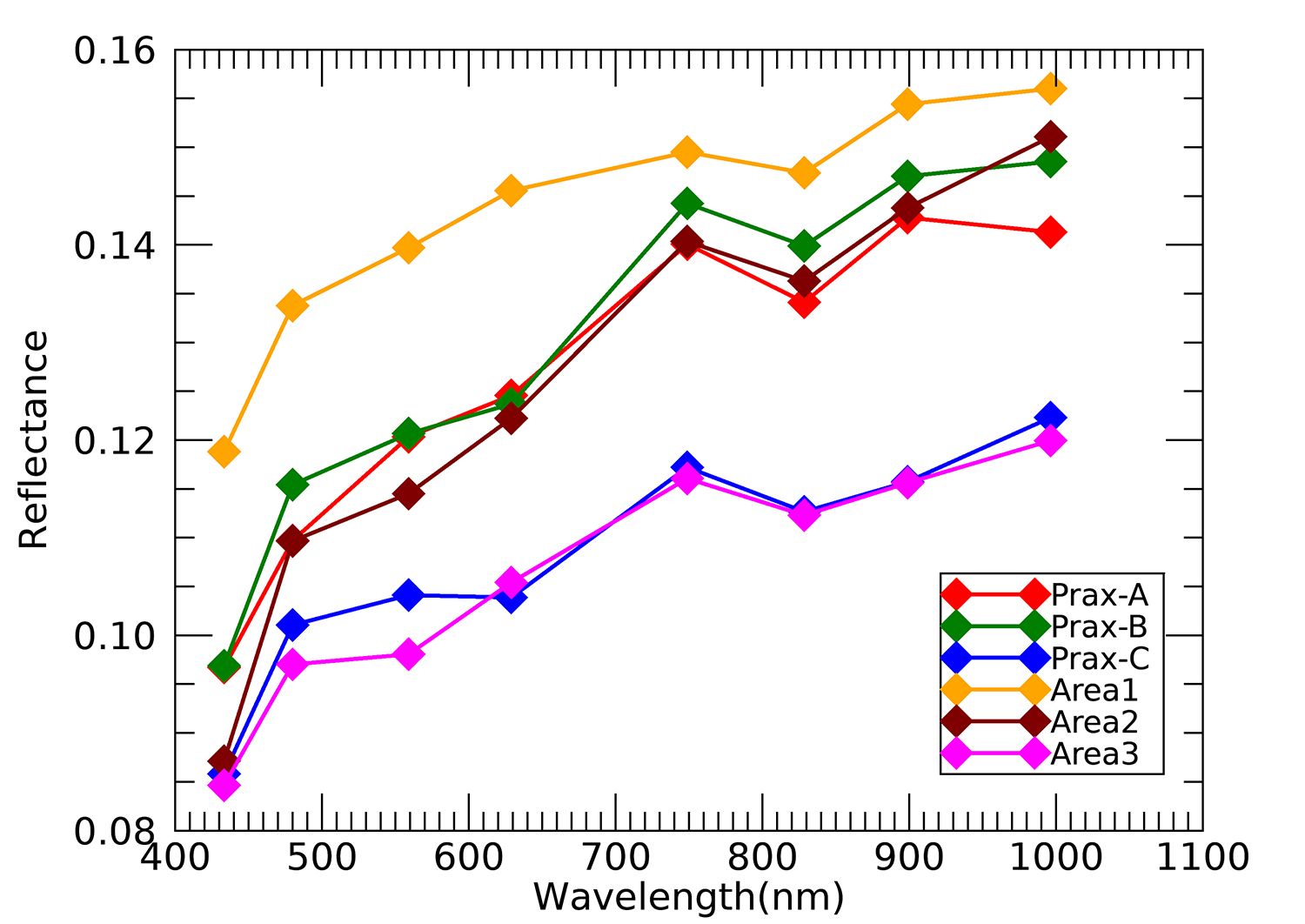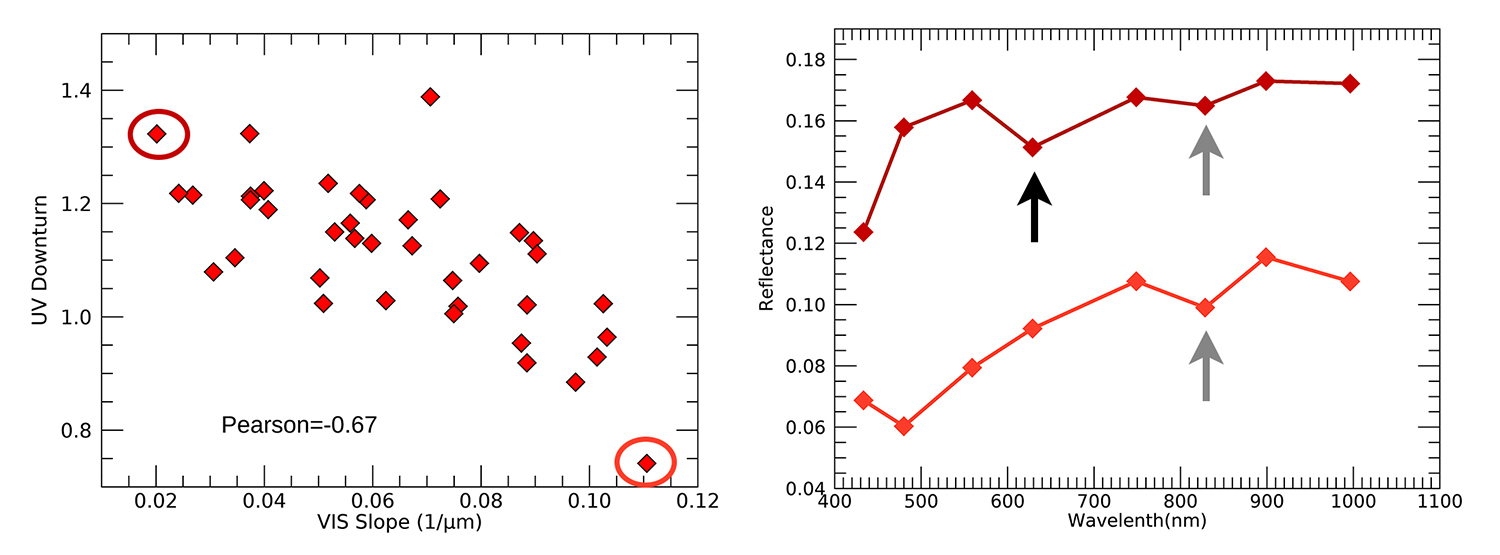Detection of a novel spectral feature at 830 nm in MDIS/MESSENGER color image of Praxiteles basin
- 1Istituto di Astrofisica e Planetologia Spaziali (IAPS-INAF), Italy (anna.galiano@inaf.it)
- 2Astronomical Observatory of Padova (OAPd-INAF), Italy
- 3Planetary Science Institute, Arizona, USA
- 4University of Naples Federico II, Italy
- 5School of Physical Sciences, The Open University, UK
- 6Deutsches Zentrum für Luft- und Raumfahrt (DLR), Germany
- 7European Space Astronomy Centre (ESAC), Spain
- 8Johns Hopkins Applied Physics Laboratory, Maryland, USA
- 9NASA Ames Research Center, California, USA
- 10University of Helsinki, Finland
Introduction
Hollows, flat-floored depressions with bright edges, are peculiar spectral units on the surface of Mercury [1,2], the only ones where an absorption band at 630 nm was detected in MDIS/MESSENGER multicolor images [3]. The feature was observed in hollows of Dominici and Hopper craters [4], extending from 559 to 828 nm in hollows of Canova and Velazquez craters [5], mainly ascribed to sulphides and chlorides [4,6], although additional components could occur, such as transitional elements, different from iron, on pyroxenes [5]. Additionally, hollows have flatter MDIS spectra [7], a strong curvature shortward of 600 nm [8] and the highest UV downturn shortward of 400 nm [8,9] in MASCS spectra [10]. We spectrally analysed the Praxiteles basin (198 km in diameter) [11], hosting hollows [12], faculae [13] and low-reflectance material (LRM) [14], the supposed parent material of hollows [12]. The floor is covered by low-reflectance blue plains (LBP) likely produced by effusive volcanism [15]. We detected a reflectance minimum at 828.4 nm in several MDIS spectra within the basin, suggesting the existence of a novel absorption band. Spectral examination and geological inspection of MDIS data link the absorption band to relatively fresh material exposed through hollows formation and/or mass wasting.
Dataset and tools
The Praxiteles basin was investigated by the MDIS/WAC multispectral image with a spatial resolution of 365 m/px. The cube is composed of 10491167 pixels and each pixel contains 8 filters, producing a reflectance spectrum from 430 to 1000 nm. The cube was photometrically corrected taking into account the topography and by applying the Hapke model using parameters derived from a global dataset [16].
Spectral parameters used for the examination include spectral slope in the 480-830 nm range (VIS Slope), the UV downturn, and the band center and depth of the spectral features at 630 nm and 830 nm. The UV downturn is the ratio between a model reflectance at 430 nm extrapolated from the visible slope derived from the 480-560 nm observations (RM) and the measured reflectance in the same filter (Rm). The spectral features at 830 nm and at 630 nm were isolated by removing a spectral continuum defined by a fitted straight line between the absorption shoulders. Band Depth (BD) [17] and Band Center (BC) were calculated from the isolated bands. The band at 830 nm is not detectable for BD values lower than 3%, so that is the detection limit of the studied spectral feature.
Results
The 830 nm band was found in the youngest and unnamed craters within Praxiteles basin, which we label as Prax-A (28.2°N, 60.3°W), Prax-B (26.1°N, 61.0°W), Prax-C (27.7°N, 60.8°W) and in three areas identified as Area1 (28.2°N, 60.3°W), Area2 (26.3°N, 58.7°W) and Area3 (28.4°N, 60.1°W), whose mean spectra are displayed in Fig.1.

Fig.1. Mean spectra of the studied areas.
The high-resolution MDIS/NAC images reveal a statistical distribution of this spectral feature on the edge of fresh gullies (Prax-A and Prax-C), on the edge of existing hollows (Prax-A, Prax-B, Prax-C, Area1 and Area2) and on the crater rim crest (Prax-A). No high-resolution MDIS images are available for Area3.
The spectra with the 830 nm band are characterized by a moderate anti-correlation (Pearson coefficient of -0.65) between the UV downturn and VIS Slope (Fig.2, left): red-sloped spectra with a low UV downturn display only the 830 nm band (light red spectrum in Fig.2, right); flatter spectra with a higher UV downturn display both the 830 nm and the 630 nm features (dark red spectrum in Fig.2, right). Generally, we find that a higher intensity in the 630 nm feature is associated with a weakening of the 830 nm band.
A preliminary comparison with MASCS spectra highlight a spatial correlation between a strong spectral curvature between 300 and 600 nm in MASCS data and the presence of the 830 nm feature.
The band could be due to Fe+ or other transition metal ions in a crystalline structure, given the spectral similarity with laboratory spectra of common rock-forming minerals hosting Fe3+, Ti3+, Cr2+, Mn3+, Cu2+ ions [18]. The basin is placed in a region with high Fe/Si [19] and the low UV downturn could indicate a deepening of the oxygen-metal charge transfer band in Fe-rich minerals [20-22,9].

Fig.2. Scatterplot of the UV Downturn vs VIS Slope (left), whose anti-correlation is linked to the occurrence of the 630 nm band together with the 830 nm spectral feature (right).
Conclusions
The novel spectral feature at 830 nm is found on the edge of hollows and bright gullies in Praxiteles basin. In addition, the 830 nm feature decreases in intensity and disappears when the spectra become similar to those of hollows. These discoveries suggest that the 830 nm feature could represent the most recent processes on Mercury, i.e. a phase preceding hollows’ formation.
References
[1] Blewett et al. (2011) Science 333.[2] Vaughan et al. (2012) LPSC 1187.[3] Hawkins et al. (2007) SSR 131.[4] Vilas et al. (2016) GRL 43.[5] Lucchetti et al. (2018) JGR:Planets 123. [6] Barraud et al. (2023) Science Advances.[7] Blewett et al. (2009) EPSL 285.[8] Barraud et al. (2020) JGR: Planets 125.[9] Goudge et al. (2014) JGR: Planets 119.[10] McClintock and Lankton (2007) SSR 131.[11] Galluzzi et al. (2016) MemSAIt 87.[12] Thomas et al. (2014) Icarus 229.[13] Kerber et al. (2011) PSS 59.[14] Klima et al. (2018) Geophys. Res. Lett 45.[15] Denevi et al. (2013) JGR: Planets 118.[16] Domingue et al. (2016) Icarus 268.[17] Clark and Roush (1984) JGR 89.[18] Burns, 1993, Cambridge University Press.[19] Nittler et al. (2020) Icarus 345.[20] Rava and Hapke (1987) Icarus 71.[21] Cloutis et al. (2008) Icarus 197.[22] Greenspon et al. (2012) LPSC 2490.
Acknowledgements
This research was supported by the International Space Science Institute (ISSI) in Bern, through ISSI International Team project #552 (Wide-ranging characterization of explosive volcanism on Mercury: origin, properties, and modifications of pyroclastic deposits). Domingue L. Jozwiack, and O. Abramov were also supported by NASA grant 80NSSC21K0165 ‘Pyroclastic Eruption Conditions on the Moon and Mercury’. O.Barraud is supported by the Alexander Von Humboldt Foundation Research Fellowship program.
How to cite: Galiano, A., Munaretto, G., Domingue, D., Carli, C., Filacchione, G., Galluzzi, V., Buoninfante, S., Rothery, D., D'Amore, M., Maturilli, A., Besse, S., Barraud, O., Jozwiak, L., Deutsch, A., Penttilä, A., Capaccioni, F., and Abramov, O.: Detection of a novel spectral feature at 830 nm in MDIS/MESSENGER color image of Praxiteles basin, Europlanet Science Congress 2024, Berlin, Germany, 8–13 Sep 2024, EPSC2024-220, https://doi.org/10.5194/epsc2024-220, 2024.